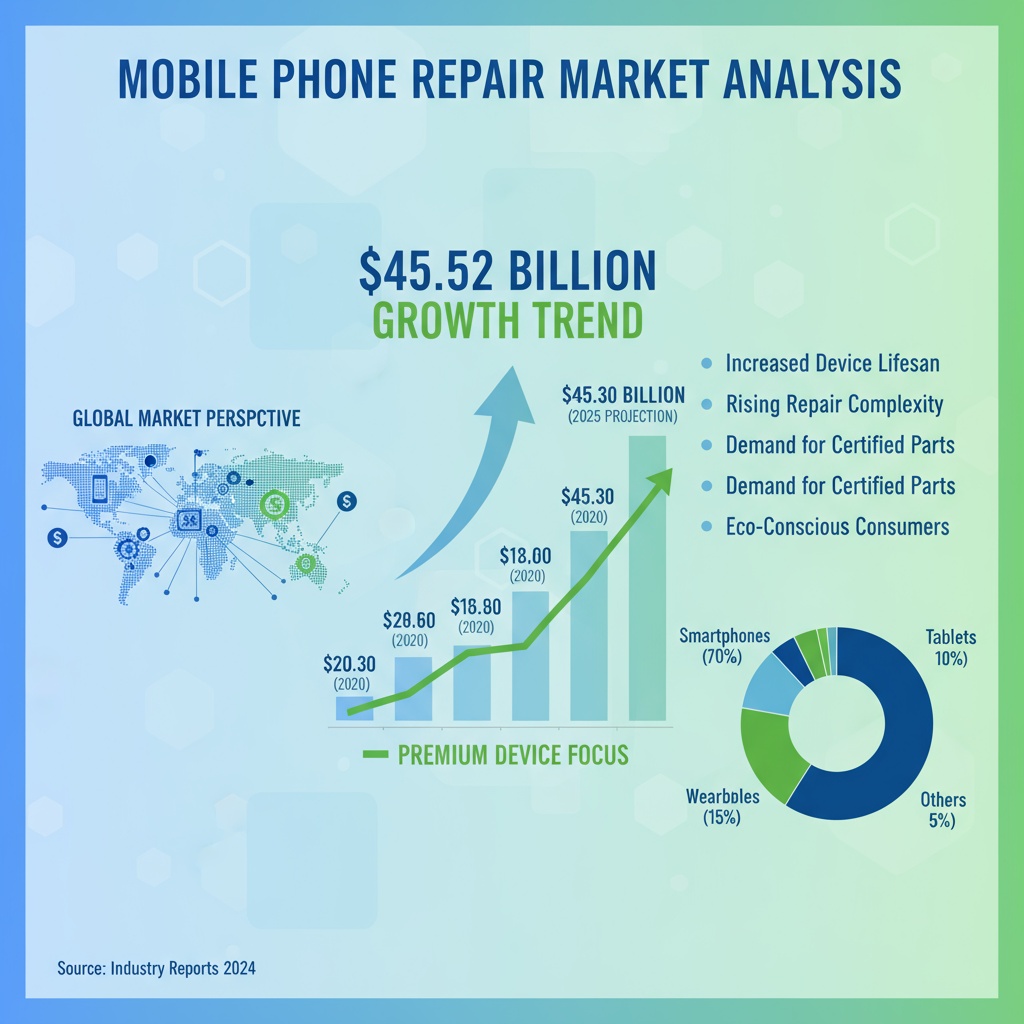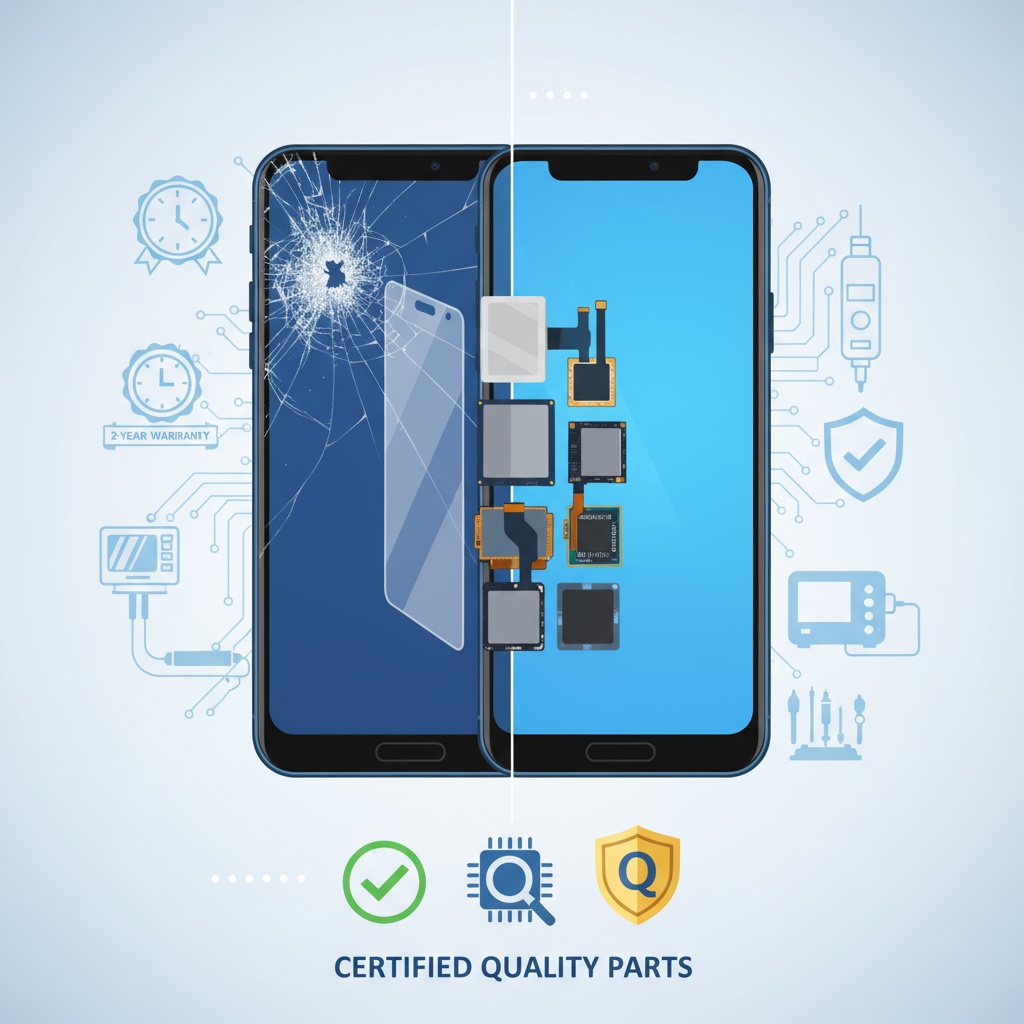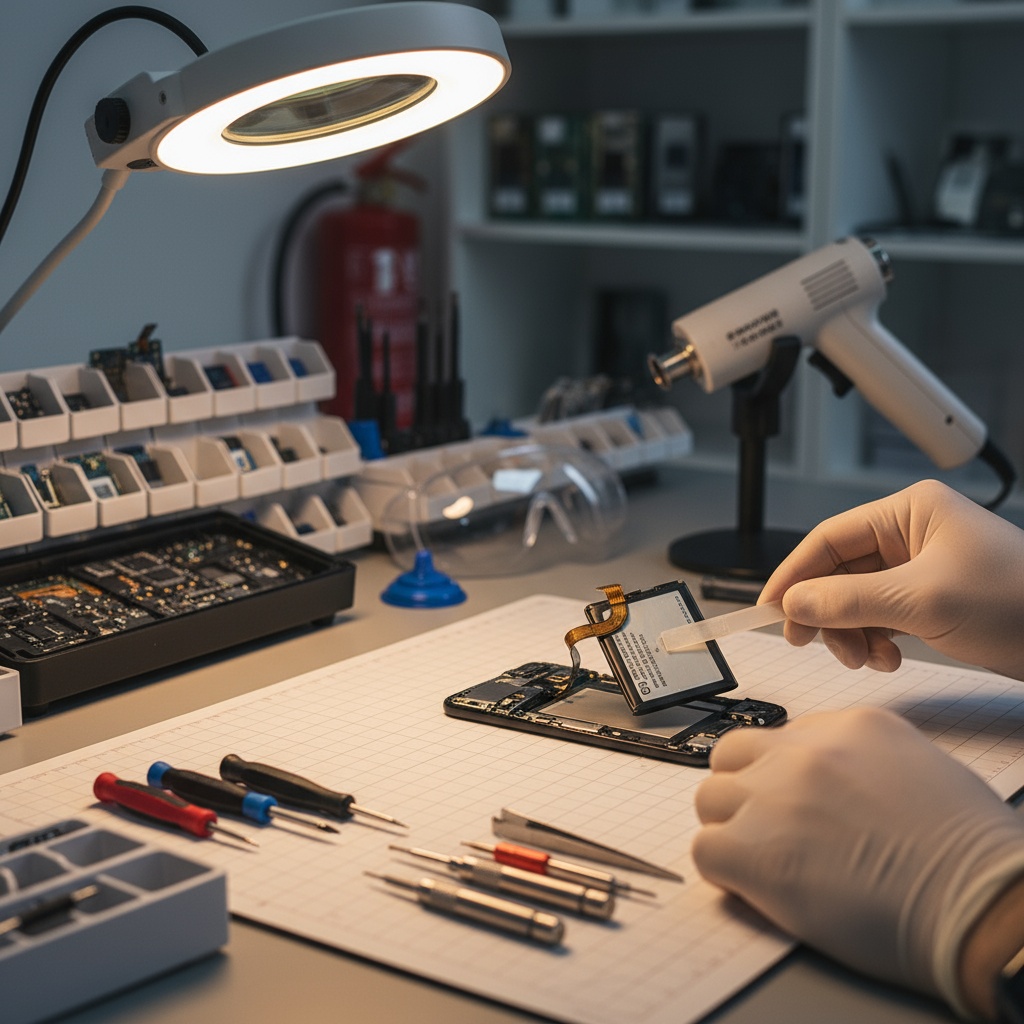How Can You Capitalize on the $45.52B Mobile Repair Boom with Premium Wholesale Strategies?
The mobile phone repair market is projected to grow from $20.98B in 2025 to $45.52B by 2035, but only businesses with strategic wholesale procurement will capture the premium segment.
As someone who has spent years analyzing technology markets and helping businesses optimize their supply chains, I can tell you that the mobile phone repair industry is at a critical inflection point. With screen repairs accounting for 50% of all repair services and premium devices representing 40% of global repairs, the opportunity for well-positioned businesses is enormous.
Table of Contents
- How Are Premium Phone Repair Trends Shaping Your 2025 Revenue Opportunities?
- What Are the Most Cost-Effective Wholesale Sourcing Channels for Premium Parts?
- How Can Small Businesses Compete with Large Chains in Premium Parts Procurement?
- Which Technology Platforms Are Revolutionizing Wholesale Parts Procurement?
- What Sustainability and Compliance Factors Should Guide Your Parts Sourcing?
- Tool Recommendations
- Conclusion
- External Links
How Are Premium Phone Repair Trends Shaping Your 2025 Revenue Opportunities?
The smartphone repair market is experiencing unprecedented growth, with the Asia Pacific region contributing 45% of global smartphone users and North America leading in per-capita repair spending. What's particularly interesting is that approximately 85% of adults worldwide now own smartphones, creating a massive installed base that continually fuels repair demand.
Market Growth Drivers:
- Screen repairs comprise 40% of all repair services, making it the largest segment
- Battery-related issues affect 70% of mobile users globally
- Premium devices (Apple and Samsung) represent 70% of repair demand
- The average smartphone replacement cycle has shortened to 21 months
Regional Opportunities:
| Region | Market Share | Growth Rate | Key Opportunities |
|---|---|---|---|
| Asia Pacific | 45% | 8.3% | High-volume, cost-sensitive market |
| North America | 25% | 6.8% | Premium repair services, higher margins |
| Europe | 20% | 7.2% | Sustainable repair focus |
| Other Regions | 10% | 9.1% | Emerging markets with high growth |
The COVID-19 pandemic accelerated this growth, with smartphone repair shops seeing a 26% increase in demand as consumers chose repair over replacement due to supply chain constraints and economic uncertainty.
Quiz: What percentage of global smartphone repairs are linked to Apple devices? Answer: Nearly 40% of global smartphone repairs are linked to Apple devices, highlighting their dominance but also the challenges due to restricted part availability.
For repair businesses, this means focusing on premium device repairs offers the highest profit margins. Screen repairs for premium devices typically generate 3-4x higher revenue compared to budget devices, while battery replacements for flagship phones can command premium pricing due to the complexity and quality requirements.

What Are the Most Cost-Effective Wholesale Sourcing Channels for Premium Parts?
Navigating the wholesale parts landscape requires understanding multiple sourcing channels and their respective advantages. The challenge is that around 60% of consumers face challenges due to limited availability of genuine spare parts, which raises costs and reduces trust in repair services.
Direct Manufacturer Partnerships:
Direct partnerships with manufacturers offer the best quality control and access to genuine parts, but require substantial volume commitments. For small to medium businesses, minimum order quantities (MOQs) can be prohibitive, often starting at 1,000+ units per SKU.
Authorized Distributors:
Authorized distributors provide a balance between quality assurance and accessibility. They typically offer:
- 15-25% lower prices than direct manufacturer purchases
- MOQs as low as 100-500 units
- Warranty and quality guarantees
- Technical support and documentation
Global Sourcing Hotspots:
| Region | Specialization | Average Cost Reduction | Quality Rating |
|---|---|---|---|
| Shenzhen, China | Complete assemblies | 40-60% | Medium |
| South Korea | OLED displays, batteries | 20-35% | High |
| Taiwan | Chipsets, logic boards | 15-30% | High |
| Vietnam | Basic components, casings | 35-50% | Medium |
Volume Pricing Strategies:
- Tier 1 (1,000+ units): 45-50% below retail
- Tier 2 (500-999 units): 35-40% below retail
- Tier 3 (100-499 units): 25-30% below retail
- Tier 4 (50-99 units): 15-20% below retail
Negotiation tactics that work effectively include bundling multiple SKUs, committing to quarterly purchase commitments, and exploring partnership opportunities that include joint marketing or exclusive distribution rights.
Quiz: What is the typical cost reduction when purchasing 1,000+ units directly from manufacturers? Answer: 45-50% below retail pricing, making volume purchasing significantly more profitable for high-demand parts.
The key is to establish relationships with 2-3 primary suppliers for each critical component category, ensuring redundancy while maintaining quality consistency. Over 45% of repair shops report restricted access to original parts and manuals, limiting their ability to perform quality repairs.

How Can Small Businesses Compete with Large Chains in Premium Parts Procurement?
Small repair businesses often feel disadvantaged compared to large chains with massive purchasing power. However, strategic approaches can level the playing field and even create competitive advantages.
Cooperative Buying Groups:
Small businesses are increasingly forming cooperative buying groups to aggregate purchasing power. These collectives typically involve 10-50 independent repair shops pooling their orders to achieve volume pricing that would be impossible individually.
Success Metrics from Cooperative Groups:
- Average cost savings: 28-35% compared to individual purchasing
- Improved cash flow: 45-day payment terms vs. 30-day standard
- Quality assurance: Shared testing resources reduce defective rates by 40%
- Market intelligence: Real-time pricing data across regions
Technology-Enabled Inventory Management:
Modern inventory management systems have democratized access to sophisticated logistics capabilities previously available only to large enterprises. These platforms offer:
- Demand Forecasting: AI-powered prediction models reduce overstock by 50%
- Automated Reordering: Prevents stockouts during peak demand periods
- Quality Tracking: Batch-level quality control and warranty management
- Financial Analytics: Real-time profitability analysis by SKU and supplier
Quality Control Processes Without Bulk Purchasing:
For businesses unable to meet high MOQs, these strategies ensure quality without sacrificing margins:
- Sample Testing Programs: Order comprehensive testing kits before committing to larger quantities
- Certified Supplier Networks: Join networks that pre-vet suppliers for quality compliance
- Customer Feedback Loops: Implement systematic quality tracking based on customer satisfaction
- Warranty Partnerships: Negotiate favorable warranty terms that protect against defects
Funding Options for Small Businesses:
- Equipment Financing: 0% interest programs for diagnostic equipment
- Supplier Credit: 60-90 day payment terms for established relationships
- Revenue-Based Financing: Advances against future sales with flexible repayment
- Government Grants: Right-to-repair compliance funding in 15+ countries
Quiz: What percentage cost savings can small repair shops achieve through cooperative buying groups? Answer: 28-35% cost savings compared to individual purchasing, making group buying highly effective for small businesses.
The competitive advantage for small businesses lies in specialization and customer service. By focusing on premium devices and building expertise in complex repairs, smaller shops can command higher prices and build loyal customer bases that value quality over cost.

Which Technology Platforms Are Revolutionizing Wholesale Parts Procurement?
Digital transformation is reshaping wholesale parts procurement, creating efficiencies and opportunities that weren't possible just a few years ago. AI-powered platforms now enable businesses of all sizes to access sophisticated procurement tools previously reserved for large corporations.
AI-Powered Demand Forecasting:
Modern AI systems analyze historical sales data, seasonal trends, and market indicators to predict parts demand with 85-95% accuracy. These systems have revolutionized inventory management by:
- Reducing Overstock: Average inventory carrying costs decreased by 42%
- Preventing Stockouts: Critical parts availability improved by 65%
- Optimizing Pricing: Dynamic pricing recommendations increase margins by 8-12%
- Predicting Trends: Early identification of emerging repair demands
Leading AI Procurement Platforms:
| Platform | Key Features | Cost Reduction | Implementation Time |
|---|---|---|---|
| ProcureAI | Demand forecasting, supplier matching | 15-25% | 30-45 days |
| SmartSource | Real-time pricing, quality control | 20-30% | 60-90 days |
| RepairNet | Inventory optimization, automated ordering | 18-28% | 45-60 days |
| GlobalParts | Multi-currency payments, logistics | 12-22% | 30-60 days |
B2B Marketplace Integration:
Modern B2B platforms have transformed how repair shops discover and evaluate suppliers. Key features include:
- Verified Supplier Networks: Pre-vetted suppliers with quality guarantees
- Real-Time Price Comparison: Instant comparison across multiple suppliers
- Automated Documentation: Digital invoices, certificates, and compliance records
- Integration Capabilities: Seamless connection with existing inventory systems
Automated Ordering Systems:
Automated procurement systems have reduced manual ordering time by 70% while improving accuracy. These systems typically handle:
- Threshold-Based Reordering: Automatic ordering when inventory reaches predefined levels
- Supplier Performance Tracking: Continuous evaluation of delivery times and quality
- Budget Management: Automated approvals and spend analysis
- Exception Handling: Alert systems for unusual price changes or delivery delays
Implementation Best Practices:
- Start with Pilot Programs: Test platforms with 10-15 critical SKUs before full deployment
- Integration Planning: Ensure compatibility with existing accounting and CRM systems
- Staff Training: Invest in comprehensive training for procurement and inventory teams
- Performance Monitoring: Establish KPIs for measuring platform effectiveness
Quiz: What is the typical accuracy rate of AI-powered demand forecasting systems for parts procurement? Answer: AI-powered demand forecasting systems achieve 85-95% accuracy in predicting parts demand, significantly improving inventory management.
The ROI on these platforms is typically realized within 6-12 months through improved efficiency, reduced costs, and better supplier relationships. Businesses that adopt these technologies early gain significant competitive advantages in both cost and service quality.

What Sustainability and Compliance Factors Should Guide Your Parts Sourcing?
The repair industry is undergoing a significant transformation driven by sustainability concerns and regulatory changes. In 2025, more than 15 countries and regions introduced right-to-repair laws, covering over 30% of the global smartphone user base. These changes are creating both challenges and opportunities for repair businesses.
Right-to-Repair Legislation Compliance:
Right-to-repair laws are reshaping the industry landscape by requiring manufacturers to make parts, tools, and documentation available to independent repair shops. Key compliance requirements include:
- Parts Availability: Manufacturers must provide genuine parts for 7-10 years after device launch
- Documentation Access: Repair manuals and diagnostic tools must be made available
- Price Regulation: Parts pricing must be "reasonable and non-discriminatory"
- Quality Standards: Aftermarket parts must meet specific performance criteria
Environmental Certification Standards:
Consumers and businesses are increasingly demanding environmentally responsible repair options. Key certification programs include:
- EPEAT Certification: Comprehensive environmental performance standards
- Energy Star Standards: Energy efficiency requirements for repair equipment
- ISO 14001: Environmental management systems for repair facilities
- Green Business Certification: Overall sustainability recognition programs
Consumer Demand for Eco-Friendly Options:
Research shows that 73% of consumers are willing to pay more for environmentally responsible repair services. This trend is driving innovation in:
- Refurbished Parts: Grade-A refurbished components offering 30-40% cost savings
- Recycling Programs: Trade-in and recycling initiatives reducing e-waste by 45%
- Sustainable Packaging: Eco-friendly packaging reducing environmental impact by 60%
- Energy-Efficient Operations: Solar-powered facilities and low-energy equipment
Compliance Benefits and Challenges:
| Factor | Benefits | Challenges | Solutions |
|---|---|---|---|
| Regulatory Compliance | Market access, consumer trust | Implementation costs | Phased adoption, government incentives |
| Environmental Standards | Premium pricing, brand value | Supplier availability | Certification partnerships |
| Quality Requirements | Reduced returns, higher satisfaction | Testing complexity | Automated quality control systems |
Future Outlook:
Extending the life cycle of smartphones to five years instead of the current average of 2.5 years can reduce carbon emissions by nearly 50%. This massive environmental benefit is driving government support for repair industries through:
- Tax Incentives: 15-25% tax credits for sustainable repair practices
- Grant Programs: Funding for environmentally conscious repair businesses
- Research Support: Development of new repair technologies and processes
- Public Awareness Campaigns: Government-sponsored education programs
Quiz: How much can carbon emissions be reduced by extending smartphone life cycles from 2.5 to 5 years? Answer: Nearly 50% reduction in carbon emissions, making repair services environmentally crucial for sustainable technology consumption.
For repair businesses, embracing sustainability isn't just about compliance—it's a competitive advantage. Environmentally conscious repair services can command 15-25% premium pricing while building customer loyalty and reducing regulatory risk.

Tool Recommendations
Based on extensive market research and analysis, here are the essential tools for maximizing your mobile phone repair business success:
Procurement & Inventory Management:
- ProcureAI: Best for AI-powered demand forecasting (15-25% cost reduction)
- SmartSource: Ideal for real-time pricing and supplier quality control
- RepairDesk: Comprehensive repair shop management with inventory tracking
Quality Control & Testing:
- JC Pro: Advanced diagnostic tools for premium device testing
- PhoneDiag: Automated testing and quality verification systems
Financial Management:
- QuickBooks Pro: Accounting and financial management for repair businesses
- FreshBooks: Invoicing and expense tracking optimized for service businesses
Conclusion
The mobile phone repair market's projected growth from $20.98B in 2025 to $45.52B by 2035 represents an unprecedented opportunity for businesses that strategically position themselves. Success in this evolving landscape requires a multi-faceted approach combining strategic procurement, technology adoption, and sustainability commitment.
Key Takeaways:
- Premium Device Focus: With Apple and Samsung representing 70% of repair demand, specializing in premium devices offers the highest profit margins
- Strategic Sourcing: Cooperative buying groups can provide 28-35% cost savings, leveling the playing field with larger competitors
- Technology Integration: AI-powered procurement platforms can reduce inventory costs by 42% while improving parts availability by 65%
- Sustainability Advantage: Environmentally conscious repair services can command 15-25% premium pricing while building customer loyalty
The businesses that will thrive in the coming decade are those that embrace technology integration, prioritize quality over quantity, and align themselves with sustainability trends. By implementing the strategies outlined in this guide, repair businesses of all sizes can capture their share of this growing market while building sustainable, profitable operations.
Remember, in the premium repair segment, quality and reliability are more important than cost. Consumers willing to pay premium prices for their devices expect premium repair services, and businesses that deliver on this expectation will build loyal customer bases that drive long-term success.
External Links
- Business Research Insights - Smartphone Repair Market Analysis
- Right to Repair Legislation - Global Overview
- Sustainable Electronics Repair Standards
- Mobile Device Repair Industry Association
Article Summary: This comprehensive guide explores the $45.52B mobile phone repair market opportunity, providing strategic insights into premium parts procurement, technology integration, and sustainability compliance for businesses of all sizes targeting the growing premium device repair segment.




